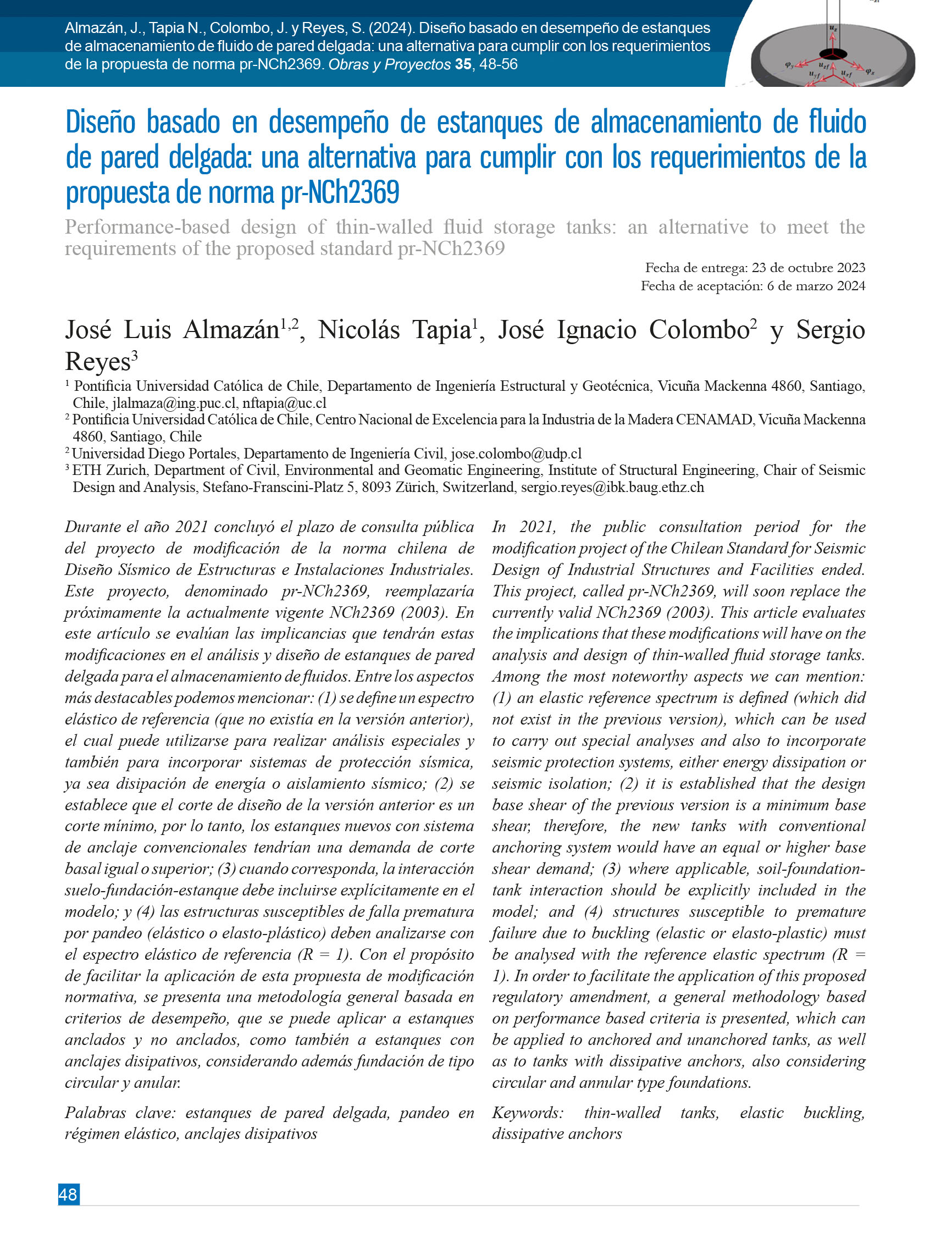Performance-based design of thin-walled fluid storage tanks: an alternative to meet the requirements of the proposed standard pr-NCh2369
DOI:
https://doi.org/10.21703/0718-2813.2024.35.2799Keywords:
Thin-walled tanks, Elastic buckling, Dissipative anchorsAbstract
In 2021, the public consultation period for the modification project of the Chilean Standard for Seismic Design of Industrial Structures and Facilities ended. This project, called pr-NCh2369, will soon replace the currently valid NCh2369 (2003). This article evaluates the implications that these modifications will have on the analysis and design of thin-walled fluid storage tanks. Among the most noteworthy aspects we can mention: (1) an elastic reference spectrum is defined (which did not exist in the previous version), which can be used to carry out special analyses and also to incorporate seismic protection systems, either energy dissipation or seismic isolation; (2) it is established that the design base shear of the previous version is a minimum base shear, therefore, the new tanks with conventional anchoring system would have an equal or higher base shear demand; (3) where applicable, soil-foundationtank interaction should be explicitly included in the model; and (4) structures susceptible to premature failure due to buckling (elastic or elasto-plastic) must be analysed with the reference elastic spectrum (R = 1). In order to facilitate the application of this proposed regulatory amendment, a general methodology based on performance based criteria is presented, which can be applied to anchored and unanchored tanks, as well as to tanks with dissipative anchors, also considering circular and annular type foundations.
References
Barton, D.C. and Parker, J.V. (1987). Finite element analysis of the seismic response of anchored and unanchored liquid storage tanks. Earthquake Engineering & Structural Dynamics 15(3), 299-322.
Colombo, J.I. and Almazán, J.L. (2019). Simplified 3D model for the uplift analysis of liquid storage tanks. Engineering Structures 196, 109278.
Cruz, E.F. and Valdivia, D. (2011). Performance of industrial facilities in the Chilean earthquake of 27 February 2010. The Structural Design of Tall and Special Buildings 20(1), 83-101.
Dizhur, D., Simkin, G., Giaretton, M., Loporcaro, G., Palermo, A. and Ingham, J. (2017). Performance of winery facilities during the 14 November 2016 Kaikōura earthquake. Bulletin of the New Zealand Society for Earthquake Engineering 50(2), 206-224.
Hall, J.F. (1995). Northridge earthquake January 17, 1994. Reconnaissance Report. EERI, Oakland, USA.
Hanson, R.D. (1973). Behavior of liquid-storage tanks. The Great Alaska Earthquake of 1964, 331–339.
Haroun, M.A. and Housner, G.W. (1981). Earthquake response of deformable liquid storage tanks. Journal of Applied Mechanics 48(2), 411-418.
Housner, G.W. (1963). The dynamic behavior of water tanks. Bulletin of the Seismological Society of America 53(2), 381-387.
Housner, G.W. (1957). Dynamic pressures on accelerated fluid containers. Bulletin of the Seismological Society of America 47(1), 15-35.
Jacobsen, L.S. (1949). Impulsive hydrodynamics of fluid inside a cylindrical tank and of fluid surrounding a cylindrical pier. Bulletin of the Seismological Society of America 39(3), 189-204.
Jaramillo, F., Almazán, J.L. and Colombo, J.I. (2022). Effects of the anchor bolts and soil flexibility on the seismic response of cylindrical steel liquid storage tanks. Engineering Structures 263, 114353.
Malhotra, P. (2000). Practical nonlinear seismic analysis of tanks. Earthquake Spectra 16(2), 473-492.
Malhotra, P.K. and Veletsos, A.S. (1994a). Beam model for base-uplifting analysis of cylindrical tanks. Journal of Structural Engineering 120(12), 3471-3488.
Malhotra, P.K. and Veletsos, A.S. (1994b). Uplifting analysis of base plates in cylindrical tanks. Journal of Structural Engineering 120(12), 3489-3505.
Malhotra, P.K. and Veletsos, A.S. (1994c). Uplifting response of unanchored liquid-storage tanks. Journal of Structural Engineering 120(12), 3525-3547.
Manos, G.C. (1991). Evaluation of the earthquake performance of anchored wine tanks during the San Juan, Argentina, 1977 earthquake. Earthquake Engineering & Structural Dynamics 20(12), 1099–1114.
Moreno, M., Colombo, J., Wilches, J., Reyes, S. and Almazán, J. (2023). Buckling of steel tanks under earthquake loading: Code provisions vs FEM comparison. Journal of Constructional Steel Research 209, 108042.
Morris, G.J., Bradley, B.A., Walker, A. and Matuschka, T. (2013). Ground motions and damage observations in the Marlborough region from the 2013 Lake Grassmere earthquake. Bulletin of the New Zealand Society for Earthquake Engineering 46(4), 169- 187.
NCh2369 (2003). Earthquake resistant design of industrial structures and facilities. Instituto Nacional de Normalización INN, Santiago, Chile.
NZSEE (1986). Seismic design of storage tanks. New Zealand National Society for Earthquake Engineering, Wellington, New Zealand.
Peek, R. and Jennings, P.C. (1988). Simplified analysis of unanchored tanks. Earthquake Engineering & Structural Dynamics 16(7), 1073-1085.
Steinbrugge, K.V. and Flores, R. (1963). The Chilean earthquakes of May, 1960: A structural engineering viewpoint. Bulletin of the Seismological Society of America 53(2), 225–307.
Tapia, N.F., Almazán, J.L., Valdebenito, N. and Reyes, S.I. (2023). Experimental validation of an energy-dissipating anchoring system for continuously-supported storage tanks. Structures 55, 2324-2340.
Veletsos, A.S. (1974). Seismic effects in flexible liquid storage tanks. 5th World Conference on Earthquake Engineering, vol. 1, 630-639.
Veletsos, A.S. and Yang, J.Y. (1977). Earthquake response of liquid storage tanks. In Advances in Civil Engineering through Engineering Mechanics. Annual Special Conference, ASCE, Raleigh NC, USA, vol. 5, 1-24.
Virella, J.C., Godoy, L.A. and Suárez, L.E. (2006). Dynamic buckling of anchored steel tanks subjected to horizontal earthquake excitation. Journal of Constructional Steel Research 62(6), 521-531.

Downloads
Published
Issue
Section
License

This work is licensed under a Creative Commons Attribution-NonCommercial 4.0 International License.







